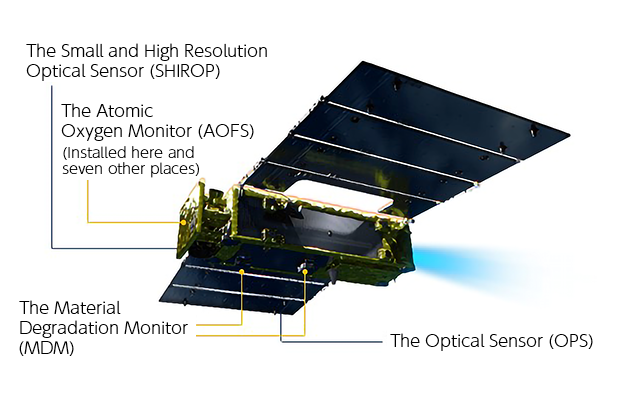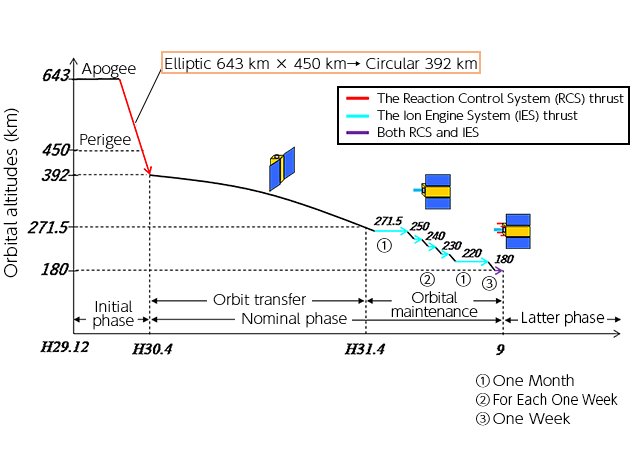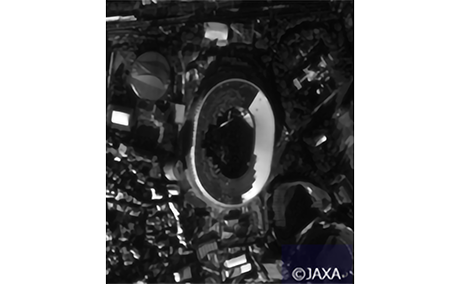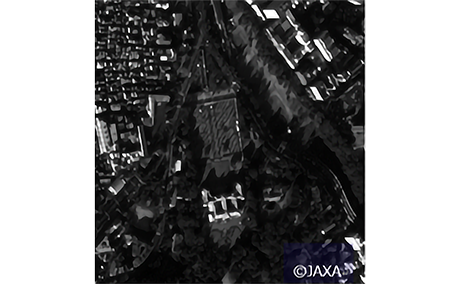Tsubame Transition to Orbit Keeping Operations
March 18, 2019 (JST)
National Research and Development Agency
Japan Aerospace Exploration Agency (JAXA)
National Research and Exploration Agency Japan Aerospace Exploration Agency (JAXA) launched Tsubame*1, The Super Low Altitude Test Satellite, on December 23, 2017. The Tsubame satellite completed its orbit transfer phase and will transition on April 2 to the orbit keeping phase, powered by the ion engines.
Designed to open up the possibilities of satellite use in a super low orbit, Tsubame gradually lowered its altitude using atmospheric drag and the onboard gas jet and has been in good health.
The ensuing orbit keeping operation executes the descent in five stages, 271.5 kilometers, 250 kilometers, 240 kilometers, 230 kilometers, and 220 kilometers. Each altitude is sustained for some time. In an orbit at 180 kilometers, the target altitude, where there is significant atmospheric resistance, the gas jet is turned on in addition to the ion engines to withstand the drag. (See the images of the orbital maintenance operation profile)
On April 2 through May 2, the Tsubame satellite will be sustained at 271.5 kilometers, its recurrent orbit.*2 Stationary measuring is scheduled every day of the month-long period above the Tokyo metropolitan area at high resolution, one advantage that satellite operation in a super low orbit affords. Thereafter, the satellite gradually lowers its altitude and enters the orbit keeping operation through September. During this operation, data is to be acquired of the atmosphere and atomic oxygen in a super low altitude. Photographing by Small and High Resolution Optical Sensor (SHIROP) will also be experimented.
*1: For more information, go to https://global.jaxa.jp/projects/sat/slats/
Tsubame three onboard mission instruments are:
(1) The Small and High Resolution Optical Sensor (SHIROP)
(2) The Optical Sensor (OPS)
(3) The Atomic Oxygen Monitor System (AMO) – comprising of the Atomic Oxygen Monitor (AOFS) and the Material Degradation Monitor (MDM)
*2: A satellite repeats its path, which is called a recurrent or sub-recurrent orbit. This orbit enables the satellite to observe the same area at regular intervals.
[Attachment]
【Computer generated image of Tsubame】

【Operational Orbits Profile】

(1) The Small and High Resolution Optical Sensor (SHIROP)
19.4 kg and 20 cm in diameter, the SHIROP is a small optical sensor, less than 10-meter resolution, designed to demonstrate observations at super low altitudes. Compared to 30 cm in diameter and 2.5 meter resolution of the Panchromatic Remote-sensing Instrument for Stereo Mapping (PRISM) onboard Daichi, the Advanced Land Observing Satellite, launched on January 24, 2006, the SHIROP is smaller and has more sensitive resolution, as it observes in a super low orbit.
Below are the images captured by Tsubame on January 2.
On April 2 through May 2, the areas above Tokyo Station and Shinjyuku-gyoen including Akasaka Geihinkan and the New National Stadium will be observed. Atmospheric resistance and other factors may change the satellite’s orbit. This may alter the measuring spots, too. Observations will proceed rain or shine, but clouds may prevent getting clear images on the ground.

Captured image above New National Stadium

Above Geihinkan and Akasaka Rikyu
(2) The Optical Sensor (OPS)
The OPS is a 1.9 kg, 2 cm in diameter instrument for wide range photographing. It returns 30 m resolution colored images.
Below are the images above Dubai, the United Arab Emirates, observed on February 4 and 10, 2018.
The right image shows measuring at the lower altitude narrows the range and heightens the resolution.

The OPS images captured at different altitudes